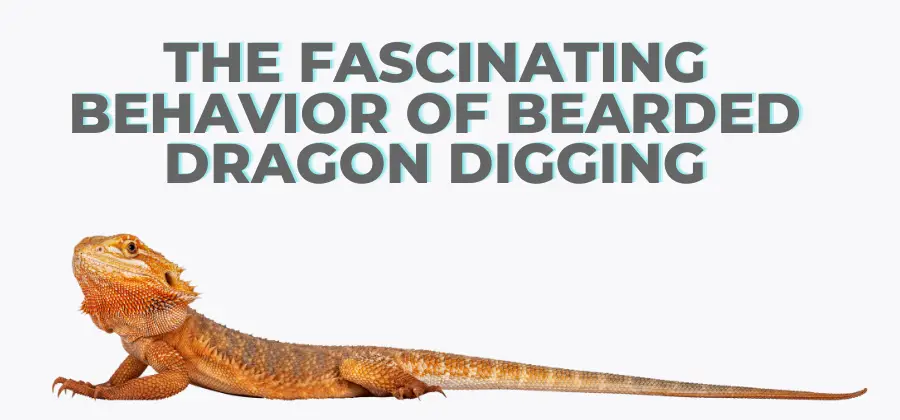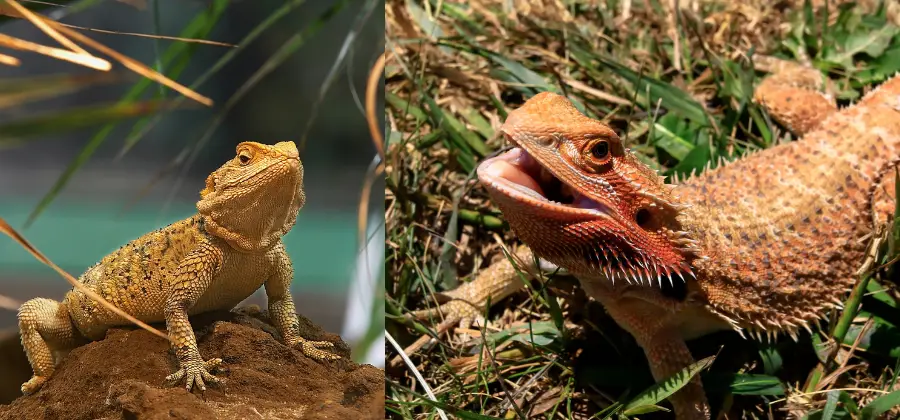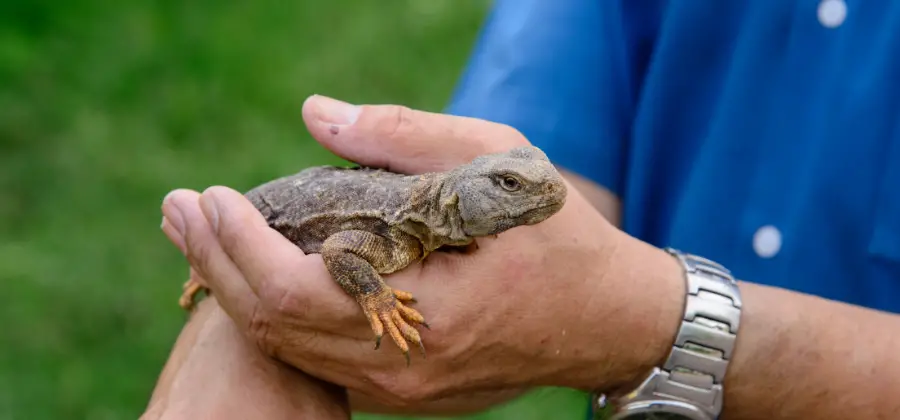Hello, Bearded Dragon fans! Have you ever seen your Bearded Dragon digging and wondered, “Why is my Bearded Dragon digging?” You’re not the only one who’s curious!
Don’t worry, we’re here to help you understand. Bearded Dragons do some pretty cool things, and digging is one of them. But why do they do it? Are they stressed, following their instincts, or is there a health problem?
In this article, we’re going to talk about why your Bearded Dragon might be digging. We’ll also give you some tips to make sure your pet stays happy and healthy. By the end, you’ll know a lot more about what your Bearded Dragon is doing and how to help them.
So, let’s start learning about your Bearded Dragon’s digging habits!
How can I provide a suitable digging environment?
Offer a substrate like reptile-safe soil or sand, provide hiding spots, and ensure proper temperature and humidity levels.
Unraveling the Mystery: The Fascinating Behavior of Bearded Dragon Digging

Digging can be a natural behavior for bearded dragons, as they typically dig or burrow in their natural habitats for various reasons. Some of these reasons include thermoregulation, creating a place to sleep or hide, and even laying eggs for female bearded dragons.
Understanding your bearded dragon’s digging behavior will not only help to ensure its health and well-being but also to create a more suitable and comfortable environment for it to thrive in.
Bearded Dragon Behaviors: Unraveling the Mysteries of Digging and Brumation
Curious about why your bearded dragon is engaging in this fascinating behavior? Don’t fret, as digging is a normal behavior exhibited by these cold-blooded reptiles. There are a variety of reasons behind their digging tendencies, so let’s explore the common factors that may contribute to this intriguing behavior.
One key reason is the need to regulate their body temperature effectively. Bearded dragons require a temperature gradient in their habitat, especially during the colder months or when exposed to bright lights. By digging in the substrate, they can find cooler spots to cool down or warmer spots to bask and maintain their optimal temperature.
Another common motive for digging is related to the breeding season or the presence of a gravid female. Female beardies may dig to create a safe spot for laying eggs. It’s crucial to provide a suitable nesting area with loose substrate, ensuring proper care during this time.
Sometimes, digging can indicate underlying health issues or stress. If your dragon exhibits signs of stress, such as glass surfing or being restless on their hind legs, it’s essential to monitor their behavior closely and consult a veterinarian if needed.
In addition to these reasons, bearded dragons may also dig in search of food or simply out of natural curiosity. Their inquisitive nature drives them to explore their surroundings. Offering a variety of insects, including fatty worms, can stimulate their hunting instincts and provide mental stimulation.
As the seasons change, especially in the colder months or during brumation season, adult beardies may dig to find a comfortable spot to hibernate. This behavior mimics their natural instincts in the wild, where they seek a safe and cozy place to conserve energy.
To ensure your bearded dragon’s well-being, provide a spacious enclosure with proper substrate, real hideouts, and optimal temperature and humidity levels. A combination of a heat lamp and UVB lights is essential for maintaining their health. Create a moist substrate area for them to dig, giving them plenty of space to exhibit their natural behaviors.
In conclusion, bearded dragon digging is a common and natural behavior that serves various purposes. By understanding their needs and offering the ideal habitat conditions, you can ensure your scaly friend is happy, healthy, and able to exhibit their fascinating digging behaviors to the fullest.
In the Northern Hemisphere, bearded dragons find their Perfect Spot, basking spot, to soak up the warmth. Bearded Dragon digs a colder Spot for brumation, about 10 degrees cooler than usual, as adult dragon.
Bearded dragons, even as Adult Bearded, seek a hot spot to regulate their body temperature. Tank temperatures should be around 35-43 degrees Celsius. Common reasons for digging include nesting or searching for food like fatty worms. Baby beardies exhibit similar behaviors.
Why Bearded Dragons Dig

Natural Behavior
Bearded dragons are native to Australia, where they live in diverse habitats ranging from deserts to scrublands. Digging is a natural behavior for these reptiles, helping them create hiding spots or burrows in their territories.
In the wild, bearded dragons dig to regulate their body temperature, escape predators, and seek shelter from extreme weather conditions.
In captivity, bearded dragons may still exhibit this digging behavior as a part of their natural instincts. Providing a proper substrate that allows digging can help promote this healthy activity in your bearded dragon’s enclosure.
Brumation
Brumation is a process similar to hibernation that some reptiles, including bearded dragons, undergo in response to colder temperatures. During brumation, bearded dragons may dig to create a secure hiding spot where they can rest and conserve energy.
It is essential to monitor your reptile’s temperature during this period and ensure that its enclosure remains within the appropriate range.
Stress
Stress can also trigger digging in bearded dragons. An unsuitable environment, improper lighting, or sudden changes in their surroundings may cause your bearded dragon to become agitated and dig as a coping mechanism.
Be sure to monitor your reptile’s behavior closely and address any potential causes of stress to maintain their well-being.
Laying Eggs
Gravid (egg-laying) female bearded dragons may exhibit digging behavior as they prepare to lay their eggs. This behavior can be observed in both fertile and infertile egg-laying females as they seek a suitable spot to create a nest.
Providing a nesting area with an appropriate substrate, such as freshly dug garden soil or damp sand, can help encourage your bearded dragon to lay her eggs safely and comfortably.
Factors Influencing Digging Behavior

Tank Conditions
Bearded dragons often engage in digging behavior due to various conditions within their tank or habitat. One factor that can influence digging is the choice of substrate used in the enclosure. Using incorrect or inappropriate substrates, such as sand or loose materials, may lead to increased digging behavior in search of a more suitable surface.
Additionally, the temperature within the tank plays a crucial role in the bearded dragon’s comfort. Proper regulation of temperatures, including a basking area and a cooler spot, is essential for their well-being and can help minimize excessive digging.
To ensure the right temperature is maintained, always use a reliable thermometer and adjust the basking lamp as needed.
Inadequate space or poor tank setup may also cause bearded dragons to dig. A proper-sized terrarium with sufficient space for movement and exploration, as well as suitable reptile furniture such as caves and hides, can help alleviate digging behavior.
Keep in mind that it is crucial to provide a proper basking area, a cool spot, and a variety of hiding places and decorations within the tank to simulate their natural habitat.
Gender and Breeding
The gender of your bearded dragon and its breeding status might affect its digging behavior. Female bearded dragons, for instance, are more likely to dig when they are gravid (pregnant) and preparing to lay eggs.
This is a natural nesting behavior exhibited by females, who will dig to bury their clutches of eggs. Providing a suitable laying area, such as a box filled with moistened soil or a towel, can help minimize stress during this process and reduce digging behavior.
Furthermore, male bearded dragons might dig or scratch as a means of asserting dominance or displaying territorial behavior, particularly if other bearded dragons are present within the same habitat.
Health and Diet
The health and diet of bearded dragons might also contribute to digging behavior. Nutritional imbalances or deficiencies, such as lack of calcium, vitamin D3, or proper supplements, can lead to stress and related digging behavior.
Make sure your bearded dragon has a varied and nutritious diet, which includes insects, plants, and other appropriate food items. A well-fed and healthy bearded dragon is less likely to exhibit stress-related digging behavior.
In some cases, digging might be a sign of an underlying illness or stressor. Therefore, if you are concerned about your bearded dragon’s frequent or excessive digging, it is a good idea to consult a veterinarian to rule out any potential health issues.
Watch Bearded Dragon Digging
How to Prevent Excessive Digging
Provide Proper Substrate
One of the primary factors in preventing excessive digging in bearded dragons is to provide them with an appropriate substrate. Loose substrates like sand or soil allow them to exhibit natural burrowing behavior, but be cautious with some materials that can cause impaction if ingested.
A safer option can be a mix of coconut coir or reptile carpet as it allows digging but reduces the risk of impaction. Regularly clean and replace the substrate to maintain a healthy environment.
Improve Enclosure Setup
Another essential aspect is to improve the overall enclosure setup. Bearded dragons need a properly sized tank, typically a minimum of a 40-gallon tank for an adult, to ensure they have enough space. The tank should include a basking area with high temperatures (95-110°F) and a cool spot (80-85°F) for thermoregulation.
In addition to proper temperatures, furnishing the habitat with reptile accessories like hides, caves, climbing branches, and decor can provide stimulation and reduce the need for excessive digging. Make sure to have at least one hide in both the basking and cool areas. Regularly rearrange the decor to keep the environment engaging for your bearded dragon.
Monitor Health and Diet
Monitoring your bearded dragon’s health and diet is crucial in preventing excessive digging. A well-balanced diet consists of insects, vegetables, and some fruits, as well as occasional supplementation with calcium, vitamin D3, and multivitamins. Consult with a vet to determine the appropriate feeding schedule and amounts for your bearded dragon.
Additionally, observe your reptile for any signs of illness or stress, as these can trigger unusual digging behaviors. If you notice any concerning symptoms or abnormal behavior, consult with a reptile veterinarian.
By following these guidelines, you can prevent excessive digging in your bearded dragon and create a comfortable, stimulating habitat for your beloved pet.
Conclusion: Bearded Dragon Digging

Bearded dragons may engage in digging behavior for several reasons. One possible explanation is that they are trying to create a comfortable and secure hiding spot in their enclosure.
Providing them with a proper substrate in their enclosure, like a mixture of sand and chemical-free soil, can help retain heat and enable natural digging behavior.
Another cause for digging in bearded dragons might be related to reproduction. Female bearded dragons often dig to create a suitable spot for laying their eggs. This has been observed in species such as the western bearded dragon, Pogona minor, which has been documented to dig burrows for egg-laying.
In some cases, a bearded dragon may experience difficulties laying their eggs, known as dystocia. Digging can indicate the reptile is attempting to lay the eggs but is unable to do so. The intervention of a veterinarian may be required, and one case study describes the successful induction of oviposition in a bearded dragon with dystocia.
To ensure the health and well-being of your bearded dragon, it is important to monitor and understand their behavior closely. Addressing any changes or concerns promptly and providing them with a suitable, enriched environment will enable your pet to thrive.

